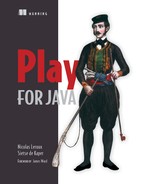Part 2. Core functionality
Part 2 takes a look at Play’s place in a greater system architecture, and dives deeper into the concepts introduced in part 1.
Chapter 4 takes a step back and takes a look at where Play fits in a more conventional enterprise architecture. It contrasts Play with conventional JEE development, and shows how Play can tackle some major challenges in such an architecture.
Chapter 5 is all about controllers. It explains what controllers are and how action methods help you interface with the web. It also explains how routing works and introduces the different scopes.
Chapter 6 covers how to handle user input. We show you how to use Play’s Form API, as well as how binding and validation work.
Chapter 7 introduces database persistence. We explain the concept of an ORM and show you how to use the Ebean ORM tool with Play. At the end of the chapter, we show how you could choose to use JPA instead of Ebean.
Chapter 8 explains how view templates work. It explains the template syntax, and shows how to use composition to structure your pages in a reusable manner. At the end of the chapter, we look at using Play’s support for LESS and CoffeeScript, and introduce the internationalization API.
